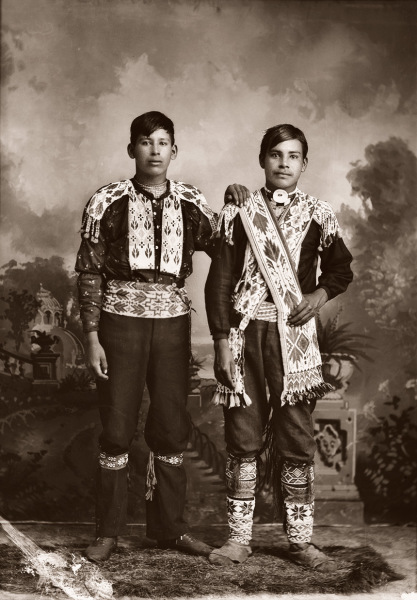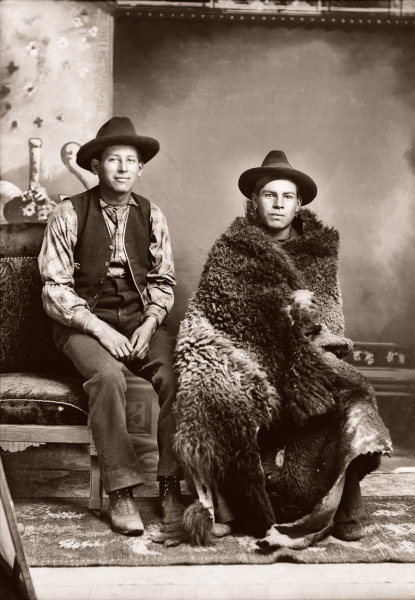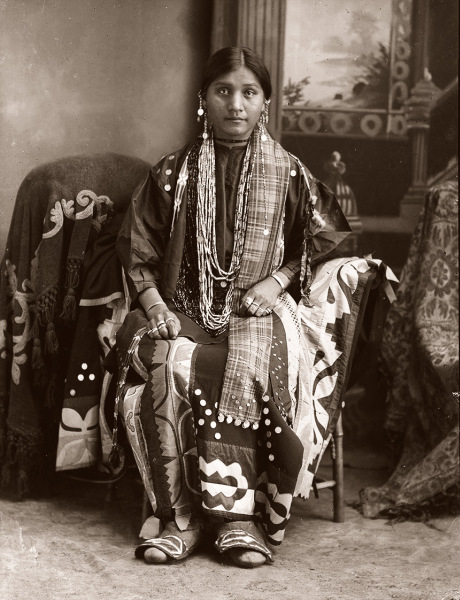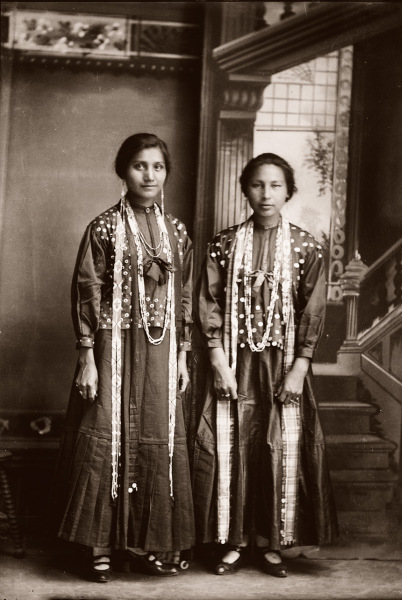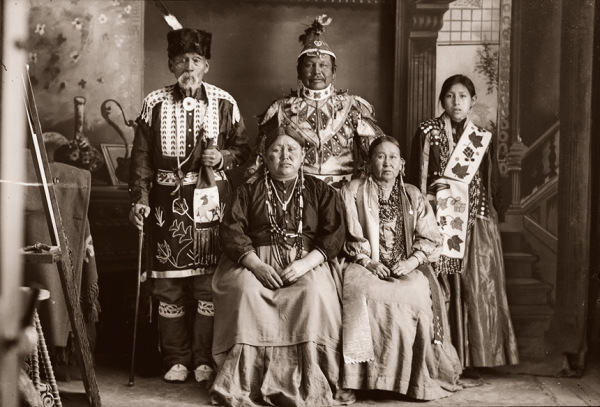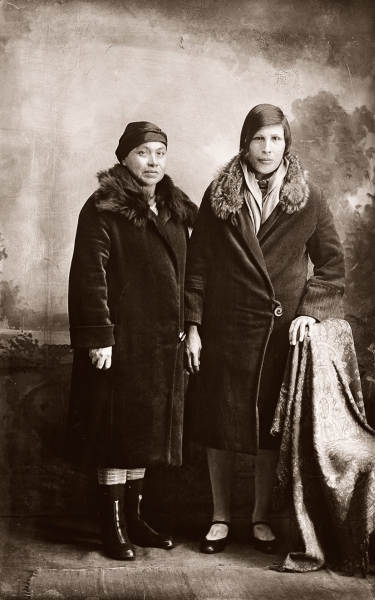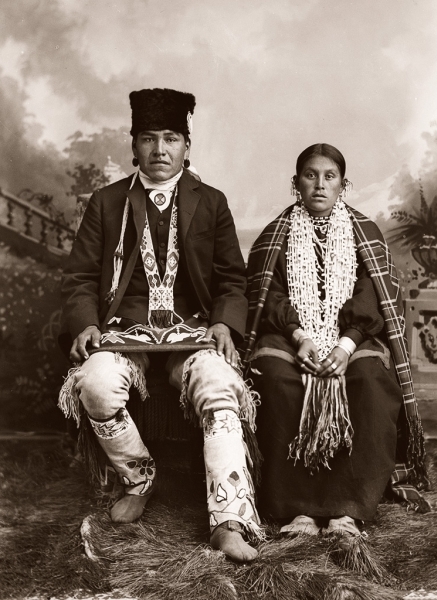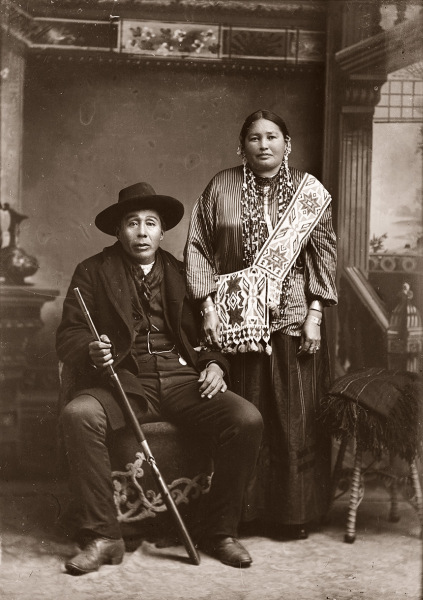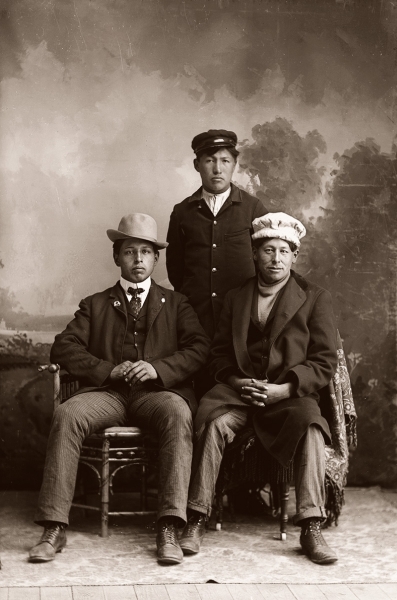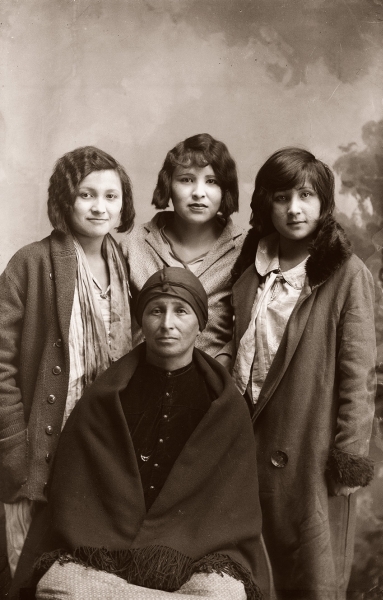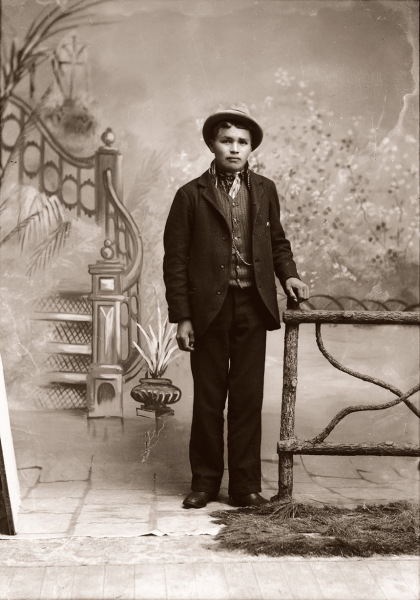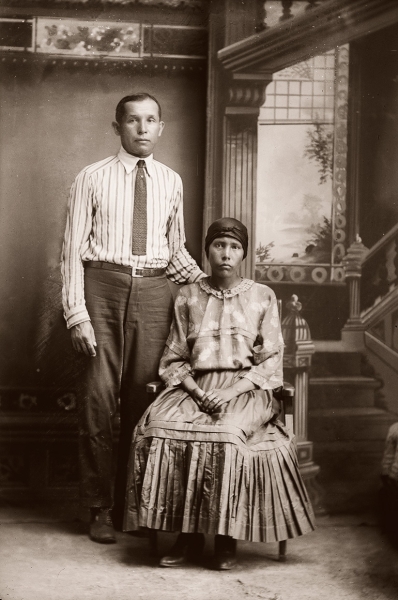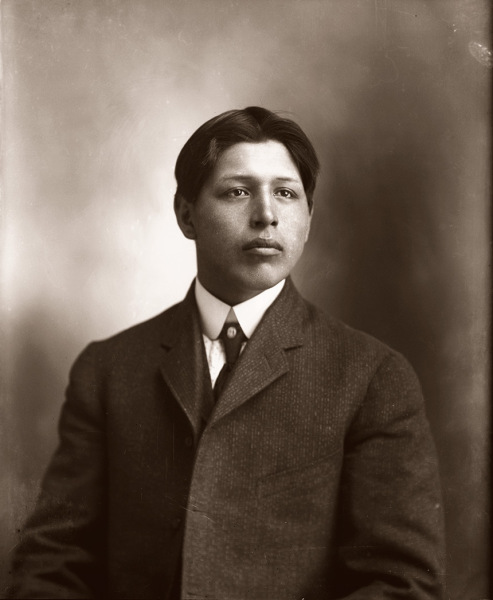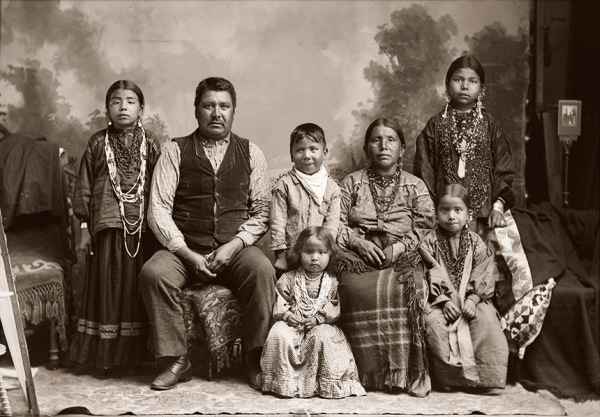
THE HO-CHUNK FAMILY AND KINSHIP STRUCTURE is quite complicated when compared to European American families and extended families. In the Ho-Chunk language, there are over ninety male kinship terms of address. Many kinship terms, especially for one’s immediate and extended family, are still in use today.
The terms of address for both men and women for the relatives of their parents and grandparents are the same. Maternal and paternal grandparents, great-grandparents, and all relatives from these generations are addressed as Cooka, translated as grandfather, and Gaaga, translated as grandmother.
One’s father and his brothers are addressed by the same name, Jaaji, which translates as father, and one’s paternal aunts are addressed as Cųųwį, which translates as aunt. One’s mother and her sisters are addressed as Nąąnį, which translates as mother, and one’s maternal uncles are called Teega, which translates as uncle. These male and female terms, Teega and Nąąnį, are also used for one’s maternal uncle’s children. These relatives are referred to in English as “little uncle” and “little mother.”
Men and women use separate terms for the children of their maternal aunts, paternal uncles, and paternal aunts. Even though these cousins have different terms of address, they are considered to be brothers and sisters. Often when a Ho-Chunk speaks about a brother or sister, they are actually talking about what a European American would consider a cousin.
A man’s brother’s children are regarded as his sons and daughters and are addressed as Hinik (son) and Hinuk (daughter), while his sister’s children are called Cuusge (nephew) and Cuuzak (niece). Similarly, a woman considers her sister’s children as her own and addresses them as Hinik and Hinuk, and her brother’s children as Cuusge and Cuuzak. Cuusge and Cuuzak are also used by older relatives and may be translated as grandson and granddaughter.
There is a special relationship between a maternal uncle (Teega) and his sister’s children. A Teega is considered more closely related to his nephews and nieces than to his own children. A Teega will give his maternal nephews and nieces whatever they ask for, and in return they will do whatever he asks. They also have what is known as a “teasing” or “joking” relationship. This reciprocal relationship also exists between a paternal aunt (Cųųwį) and her nephews and nieces, and between a woman and her brothers-in-law and a man and his sisters-in-law. These kinship and joking relationships are still practiced among the Ho-Chunk.
Frank Winneshiek (WaConChaHoNoKah), left, and Henry Winneshiek (WaConChaRooNayKah), ca. 1894. Both are wearing beaded shirts, belts, and garters. Henry is wearing Ho-Chunk moccasins, two bandolier bags, and a bone choker with a shell. Traditionally this choker was worn as armor to protect the throat during battle.
Frank Winneshiek (WaConChaHoNoKah), left, and Henry Winneshiek (WaConChaRooNayKah), wearing a buffalo robe (waį cexjį), ca. 1899.
Liddy Walkingcloud Winneshiek (KsoonchEMonEWinKah) and her husband, Little (Nady) Winneshiek (NoGinKah), ca. 1895. Little Winneshiek wears a finger-woven sash and eagle feather on his head and two George Washington Indian Peace Medals around his neck.
Liddy Walkingcloud Winneshiek (KsoonchEMonEWinKah) and Little (Nady) Winneshiek (NoGinKah), ca. 1895.
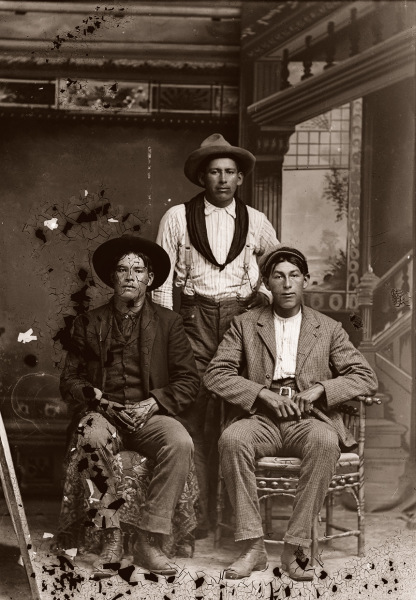
From left to right, Henry Winneshiek (WaConChaRooNayKah), Frank Winneshiek (WaConChaHoNoKah), and Richard (Luther) Winneshiek (MaHeKeeZheeNaKah), ca. 1905.

John Blackhawk (NoJumpKah) is seated to the left of Lucy Long-Wolf Winneshiek (ShunkChunkAWinKah), ca. 1904. Standing left to right are Henry Winneshiek (WaConChaRooNayKah), Edward Winneshiek (NaZhooMonEKah), and George Lonetree (HoonchXeDaGah).
Edward Winneshiek (NaZhooMonEKah), left, wearing a rare floral hand-beaded Ho-Chunk shirt and loom-beaded belt, sits next to Annie Lucy Yankee Bill (HaTaHeMonEWinKah).
Rachel Funmaker Winneshiek (HockJawKooWinKah), left, is seated next to Fannie Winneshiek (HoChunkEHoNoNeekKah), ca. 1904.
Rachel Funmaker Winneshiek (HockJawKooWinKah) sits next to Mary Thunderchief Snowball (WaSayMaKaWinKah).
Annie Blowsnake Thundercloud (WaConChaSkaWinKah), ca. 1882. Annie had just completed a silk appliqué dress (wawaje) when she stopped in at Van Schaick’s studio. Moments before the photograph was taken, Annie’s mother draped several large necklaces of white bugles and shells around her neck, completely covering her appliqué. Annie’s face registers her disappointment. Fine regalia complements the ensemble: silver bracelets (žuura sgaa aipa), earrings (woorušik), rings (nąąp hirusgic), and traditional Ho-Chunk moccasins (caahawaguje).
Photographs of this type were made into postcards and sent to relatives in other Ho-Chunk settlements to serve as notice to eligible young men of the young woman’s appearance and dowry in wampum necklaces (wanąpį) and jewelry.
Benjamin Raymond Thundercloud (NySaGaShiskKah), son of Annie Blowsnake Thundercloud (WaConChaSkaWinKah) and Moheek Thundercloud (MaZheeWeeKah), wears a mix of Ho-Chunk regalia and items from other tribes, ca. 1912. The eagle feather bonnet, commonly referred to as a war bonnet (mąąšų wookąnąk), was not traditionally worn by the Ho-Chunk but was adopted from the Plains tribes after the Ho-Chunk participated in Wild West shows. His shirt (woonąžį) is a traditional Ho-Chunk beaded shirt with loom-beaded strips sewn on the shoulders and the upper front. The beaded armbands (aapara), beaded belt (ceehį), garters, and breechcloth (táanį wóroh´įc) are Ho-Chunk. The pipe bag and moccasins are a Plains Indian style.

Moheek Thundercloud (MaZheeWeeKah) and Annie Blowsnake Thundercloud (WaConChaSkaWinKah), seated in front of their son, Benjamin Raymond Thundercloud (NySaGaShiskKah), ca. 1903.
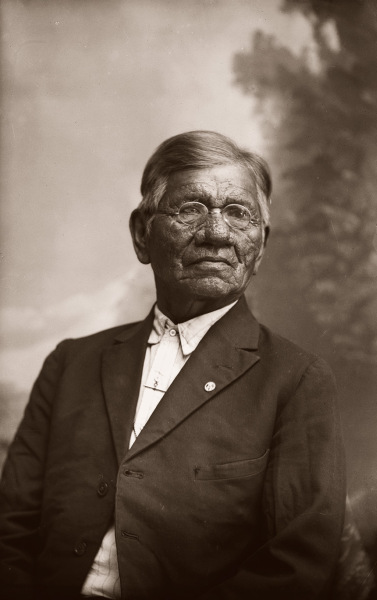
Moheek Thundercloud (MaZheeWeeKah) as an older man, ca. 1925. It was very rare for Ho-Chunk to wear eyeglasses in Van Schaick’s photographs.
Sarah B. Windblow Thundercloud (HeChoWinKah) sits next to her sister Nellie Windblow Decorah (HaWePinWinKah), who is dressed in a white school uniform, ca. 1909. Sarah’s son Lawrence Leonard Thundercloud (CooNooKah) is resting in a Ho-Chunk cradleboard.
Flora Thundercloud Funmaker Bearheart (WaNekChaWinKah), daughter of Moheek Thundercloud (MaZheeWeeKah) and Annie Blowsnake Thundercloud (WaConChaSkaWinKah), ca. 1910. Flora is seated in a chair covered by a silk appliqué blanket (waį) and is dressed in a fine appliqué dress (wawaje) with silver dimes attached to the skirt. The plaid ribbon with silver coins hanging on her left side and the strip of side-stitch beadwork (paaxgeš) hanging over her right shoulder would have been worn down the back extending from her hair wrap, but they have been brought to the front for the photograph. Small silver coins accent her blouse. The flaps of Flora’s moccasins (caahawaguje) are decorated in silk appliqué to match her dress. Many Ho-Chunk moccasins of this style have the top flaps decorated with beadwork.
Flora Thundercloud Funmaker Bearheart (WaNekChaWinKah), left, and Mary May Thundercloud Deer (WaNeekPiWinKah) wear blouses covered with small silver brooches (hiiwapox) and contemporary shoes, ca. 1920. Blouses covered with hiiwapox were sometimes referred to as “buckle blouses” because the brooches looked like miniature buckles.

Flora Thundercloud Funmaker Bearheart (WaNekChaWinKah), left, and Sarah B. Windblow Thundercloud (HeChoWinKah), ca. 1920. Both wear floral beaded bandolier bags across their shoulders.

Flora Thundercloud Funmaker Bearheart (WaNekChaWinKah), left, and Emma Annie Funmaker Lowe (ENooGreHeReKah) wearing basic women’s dresses or hįnųkwaje, ca. 1920.
Alec (Alex) Lonetree (NaENeeKeeKah) is dressed in a mix of Ho-Chunk and non-Ho-Chunk regalia, ca. 1910. His moccasins and pipe bag are Plains Indian style.
Standing are John Hazen Hill (XeTeNiShaRaKah), Alec (Alex) Lonetree (NaENeeKeeKah), and Mary Clara Blackhawk (WaHoPiNiWinKaw), daughter of Lucy Emerson Brown; sitting are Lucy Emerson Brown (HeNuKaw), left, and Lucy Long-Wolf Winneshiek (ShunkChunkAWinKah), ca. 1900.
Standing are Hugh Lonetree (NoCheeKah), left, and George Lonetree (HoonchXeDaGah); seated are Alec (Alex) Lonetree (NaEneeKeeKah) and his wife, Lucy Emerson Brown (HeNuKaw), a Winnebago from Nebraska, ca. 1915.

From left to right, Hugh Lonetree (NoCheeKah), Jesse Stacy (CooNooKah), and Alliston Winnesheik (MoNaKaKah), ca. 1915.

Standing are George Lonetree (HoonchXeDaGah), left, and Harry Funmaker (HaGaChaCooKah); seated are Fred Peter Wildrice Bearchief (WaGeSeNaPeKah), left, and Julius Whitedog (ChakShepWasKaHeKah), ca. 1908.
Hugh Lonetree (NoCheeKah) with his wife, Mary Lucy Sine (Trout) Littlesoldier Lonetree (WaHoPinNeeHaTaKah), and son Jacob Littlesoldier, ca. 1916.
George (Lyons) Lowe (AhHaZheeKah) stands with his wife, Lena Nina Marie Decorah (Lyons) Lowe (AhHooSkaWinKah), and their infant son Martin (MaHisSkaKah), ca. 1895. The Lowes were first listed on the census as Lyons, taking the name of a farmer they had worked for. The last name was later changed to Lowe.

Joe Thunderking Lowe (King of Thunder) (WauKonJahHunkKah), seated, wears Ho-Chunk-style bandolier bags across his chest, an Indian trade blanket on his lap, and Ho-Chunk moccasins. He is leaning on a pedestal that is draped with bandoliers of beads, hair pipe bone, and silver conches. David Davis W. Decorra (NeZhooLaChaHeKah) is dressed in contemporary clothing that has been accented with a Ho-Chunk beaded belt and a tie decorated with German silver brooches (hiiwapox), ca. 1895.
The family of Joe Thunderking Lowe (King of Thunder) (WauKonJahHunkKah), ca. 1904. Standing in back from left to right are Gilbert Thunderking Lowe (WaConChaHoNoNeeKah), Albert Thunderking Lowe (ChakShepSkaKah), Fred Kingswan (MaHeNoGinKah), Annie Thunderking Lowe (WaNukScotchEWinKah), and Sam Thunderking Lowe (HoChumpHoNikKah). In the front row from left to right are Lucy Thunderking Lowe Yellowbank (MaHiSkaWinKah), Minnie Thunderking Lowe (ENooKahHooNooKah), Joe Thunderking, Dora Thunderking Lowe (AkSeKahHoNoKah), Mary Decorah Thunderking (KaNooKayWinKah), Theodore Thunderking Lowe (WaConChaHoNoNikKah) sitting on his mother Mary’s lap, and Alice Thunderking Lowe Kingswan (MaHayPaSayWinKah) holding Violet Kingswan (WeGoSeeDaWinKah).

George (Lyons) Lowe (AhHaZheeKah) with his wife, Lena Nina Marie Decorah (Lyons) Lowe (AhHooSkaWinKah) and family, ca. 1903. Standing in front of George are their children, Lydia Lowe, Daniel Lowe, and Bessie Lowe.
Dora Thunderking Lowe (AkSeKahHoNoKah), right, and Jennie Youngthunder Decorah (PetHakChaCooWinKah) in winter coats, ca. 1930.

Lucy Thunderking Lowe Yellowbank (MaHiSkaWinKah), sitting left, holds her nephew David Neil Lincoln Jr. (WaWaHasKah), with her sister and the mother of David, Annie Thunderking Lowe Lincoln (WaNukScotchEWinKah), standing, and Sarah Half-a-Sack Longmarsh (NeeZhooJhotchKayWinKah) seated right, ca. 1915.

Standing are Lucy Thunderking Lowe Yellowbank (MaHiSkaWinKah), left, and Mamie (Minnie) Bearchief (HoHumpCheKaRaWinKah); seated are Hannah Whitefish, left, and Edna Grizzlybear, ca. 1920.
Martha Lyons-Lowe Stacy (KaRaChoWinKah) holds her son James Stacy (NaHeKah), ca. 1904. James, son of John Stacy (ChoNeKayHunKah), died at the age of two.
Albert Thunderking Lowe (ChakShepSkaKah), left, and Edward Funmaker (WaGeSeNaPeKah), ca. 1905. Edward wears a flannel shirt with two ribbons (zeenįba) sewn down the front.

Edward Funmaker (WaGeSeNaPeKah) and his wife, Mamie (Minnie) Bearchief Funmaker (HoHumpCheKaRaWinKah), ca. 1905.
Edward Funmaker (WaGeSeNaPeKah) stands to the left of John Stacy Jr. (HaGaKah), who wears a Ho-Chunk beaded shirt, belt, and a beaded hat band, ca. 1905.
Frank Washington Lincoln (ChakShepKonNeKah), dressed in the style of a single man with crossed bandolier bags, ca. 1902.
Edward Funmaker (WaGeSeNaPeKah), left, and Frank Washington Lincoln (ChakShepKonNeKah), seated, ca. 1900.

Frank Washington Lincoln (ChakShepKonNeKah) and his first wife, Betty Otter Lincoln (NaChoPinWinKah), ca. 1905.

Howard Joseph McKee Sr. (CharWaShepInKaw), a Nebraska Winnebago, seated next to Frank Washington Lincoln (ChakShepKonNeKah), ca. 1902. Howard wears old-style Ho-Chunk men’s moccasins with a large top flap that could be pulled up over the ankle and tied on the leg, making it a boot.
Ed Greengrass (CheWinCheKayRayHeKah) and his wife, Jennie (Johnnie) Blackhawk (CheNunkMonEWinKah). Ed wears an otter-fur turban and floral appliqué beaded aprons and leggings, ca. 1895.
Green Grass (HaWinChoKah) wears floral beaded Ho-Chunk moccasins and holds a map of Jackson County that shows his forty-acre allotment, ca. 1910.
George Greengrass (WauKeCooPeRayHeKah) and Emma Lookingglass Greengrass (ChayHeHooNooKah), ca. 1900. Emma is wearing a bandolier with an offset top strap, which was common to Ho-Chunk bandolier bags.
George Greengrass (WauKeCooPeRayHeKah) and his wife, Emma Lookingglass Greengrass (ChayHeHooNooKah), ca. 1900.
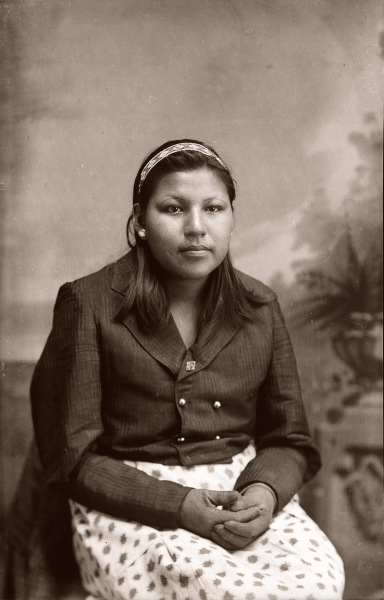
Dorothy Greengrass, daughter of Robert Greengrass (HoNutchNaCooMeeKah) and Dora Whitefeather Decorah (HoHaWinKah), ca. 1935.
Harry Littlesnake (HaKaChoMonEKah) and Annie Youngswan Snake (WaKaChaMaNeeKah) seated in front of James or George Swan, ca. 1931.
From left to right, Margaret Whitedeer Littlesam (NauChoPinWinKah), Lee Dick Littlesam (HaNotchANaCooNeeKah), and Emma Stacy Whitedeer Lowery (HompInWinKah), ca. 1898.
Little Sam (HePaHeKah) stands next to Margaret Whitedeer Littlesam (NauChoPinWinKah); Emma Stacy White-deer Lowery (HompInWinKah) is seated to the left of Sarah French (Ellen Davis) (AhHooChoWinKah), ca. 1900.
The Whitebear family was referred to in the census rolls with the last name of White, but they used the name Whitebear. From left to right are Ella Whitebear (MauNaPayWinKah), father Jim Whitebear (HoonchSkaKah), Dan Whitebear (HeNukKah), mother Kate Thundercloud Whitebear (MawHePauSayWinKah), and Daisy Whitebear (WeHunKah). Lucy Whitebear (HoDaHooKah) sits in front of Dan, and Viola Whitebear (UkSeUkKah) sits in front of Daisy, ca. 1906.
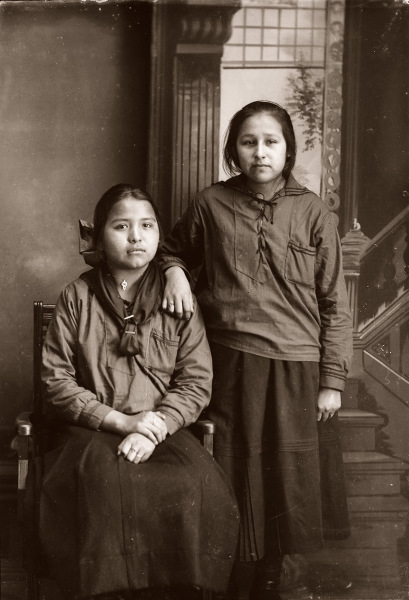
Lucy Whitebear (HoDaHooKah) seated next to Mary (Pinkah) Lewis (KeSaWinKah), ca. 1930.
Susie Kingswan (HeNuKah) wears a fine pair of floral beaded Ho-Chunk moccasins, ca. 1894. Her son Fred Kingswan (MaHeNoGinKah) wears traditional leather leggings (wagucą) and beaded garters.
Frank Lewis (HaNaCheNaCooNeeKah) stands behind Fred Kingswan (MaHeNoGinKah), left, and John Swallow (MonKeSaKaHepKah), ca. 1904.
Mark Henry stands behind Fred Kingswan (MaHeNoGinKah), left, and his brother Elias Henry, ca. 1931. The Henry boys were from Nebraska.
Rachel Whitedeer Littlejohn (ENaKaHoNoKah), front, with daughters Florence Littlejohn Lamere (HoonchHeNooKah), left, Mary Littlejohn Fairbanks (WeHunKah), and Ann Littlejohn Lonetree (WakJaXeNeWinKah), ca. 1930.
Frank Yellowfeather Climer (HawKahKah), ca. 1895. Frank and Emma E. Climer (ENooKaStaLaKah) were the parents of Susie and Bertha Climer.

Agnes Payer Climer, seated, and her daughter Juanita June Climer, ca. 1932.
Bertha Climer stands behind her sister-in-law, Agnes Payer Climer, left, and sister, Susie Climer, ca. 1931. Agnes was married to Bertha and Susie’s brother, Thor.

Seated are Dorothy Greengrass, left, and Edna Climer. Standing are Edna’s twin Jennie Climer, left, and Ollie May Sine, ca. 1934.

Emma Climer, ca. 1930.
Felix White-Wilson of Nebraska stands next to his first wife, who is listed in the census as a “New York Indian,” ca. 1925. This was a common listing for the Wisconsin Oneida, Brotherton, and Stockbridge-Muncee Indians. After his first wife passed away, Felix married Agnes Eagle (HaHumpAWinKah).
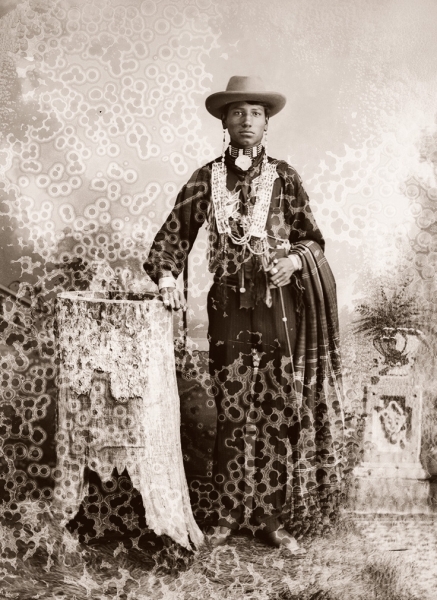
Thomas Thunder (HoonkHaGaKah) leans on a stump used as a prop in Van Schaick’s studio, ca. 1886. He is adorned with earrings and a choker.

Will Thunder (NaNikSayWaHeKah) is seated on an embroidered blanket that appears in many of Van Schaick’s photographs, ca. 1902. This blanket was not Ho-Chunk, but a studio prop.
Charlie Greengrass (HoeHumpCheeKayRayHeKah) stands to the left of Will Thunder (NaNikSayWaHeKah), ca. 1899.
Thomas Thunder (HoonkHaGaKah) sits between Emma Thunder Littlesoldier (WePaMaKaRaWinKah), left, and his wife, Florence Littlesoldier Wallace Thunder (MauKonNeeWinKah), ca. 1905.
William Thunder (WaConChaHaTeKah) is seated to the left of his wife, Mary Mollie Prophet Thunder (HoWaChoNeWinKah). Their children are seated in front of them: Kate Thunder (WaRoSheSepEWinKah), left, and Lucy Thunder (ENooKahKah). The young woman resting her hand on William’s shoulder is unidentified.

Will Thunder (NaNikSayWaHeKah) and Emma Mary White Greencloud-Redcloud Thunder (JumpBroShunNupChunTinWinKah), seated in front of their daughter, Ivy Thunder (Kate Greencloud), ca. 1918.

Thomas Thunder (HoonkHaGaKah) and his wife, Florence Littlesoldier Wallace Thunder (MauKonNeeWinKah), ca. 1895.
Mary Mollie Prophet Thunder (HoWaChoNeWinKah) holds her daughter Kate Thunder (WaRoSheSepEWinKah), ca. 1891.
Thomas Thunder (HoonkHaGaKah) wears elaborate Ho-Chunk regalia, including an eagle feather bonnet, floral beaded shirt and breechcloth, loom-beaded bandolier bags, choker, and an Indian Peace Medal. He holds a calumet pipe, ca. 1910.
Caroline Mary Decorah Blackdeer (CheHeTeChaWinKah), left, wears a silk appliqué blanket (waį zeenįbawoore), and Kate Thunder Miner (WaRoSheSepEWinKah) wears a shawl (waį) embellished with silver brooches (hiiwapox), ca. 1906.
Kate Thunder Miner (WaRoSheSepEWinKah) stands next to Hilda Alice Stacy Funmaker (HoWaChoNeWinKah), ca. 1922.

Lucy Wilson Blackhawk (HoChunkEWinKah), seated, with Donald (Dun) Blackhawk, left, Margaret Blackhawk, and Virginia Blackhawk, ca. 1932.
Clara Kingsley (Big) Blackhawk (KeesKawWinKah) carries her son Andrew John (Big) Blackhawk (WaConChaHoNoKah) on her back, ca. 1887. Using a shawl as a back sling was a common way to carry infants in this period.
Will Stohegah Carriman (WonkShiekStoHeGah), seated next to Andrew John (Big) Blackhawk (WaConChaHoNoKah), wears a beaded belt and bandoliers across his chest, ca. 1893.
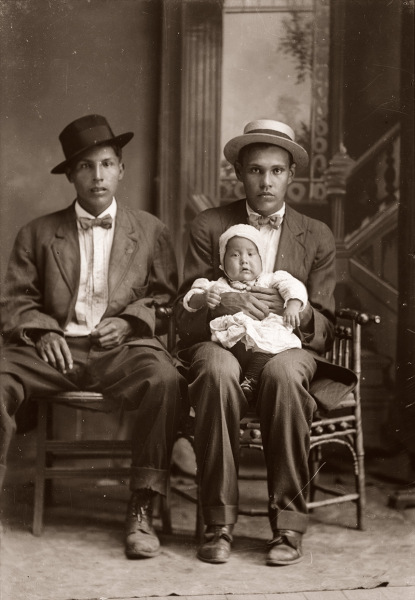
Andrew John (Big) Blackhawk (WaConChaHoNoKah) holds his son Clarence Blackhawk (WaCheeWaHaKah) and is seated next to an unidentified man, ca. 1911.

Andrew John (Big) Blackhawk (WaConChaHoNoKah), a World War I veteran, is pictured here in 1926. The Ho-Chunk powwow grounds near Black River Falls, Wisconsin, were donated to the tribe in his honor. They were part of the original forty acres allotted to his family.
